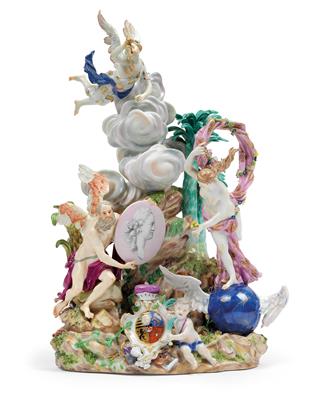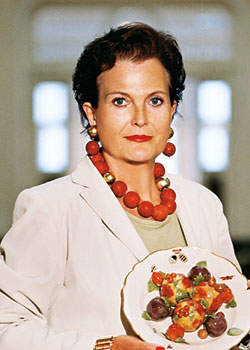‘The Glorification of the Prince Electorate of Saxony’ with a portrait of ‘Maria Josepha of Austria’,
‘The Glorification of the Prince Electorate of Saxony’ with a portrait of ‘Maria Josepha of Austria’,

and the allegories of time, luck and fame, Chronos holding an oval medallion with a bust in profile painted en grisaille on a pink ground, to one side stands the goddess Fortuna on a winged globe, in his right hand a wafting piece of fabric wound with flowers, in his left hand a bouquet of flowers intended to represent the future flourishing of the land, above which hovers Fame on a bank of clouds, blowing her trumpet, to the centre of the base, the crowned Prince Electoral coat-of-arms with Electoral hat, below which attributes of the fine arts of painting, music, poetry, sculpture and astronomy with a compass, to one side a small genius with palm branches in his hands, rocky base with 3 palm trees, clumps of grass, floral and foliate stem and mushrooms, porcelain polychrome and gilt figural group, height 37.5 cm, some restoration, Meissen, underglaze blue sword mark with dot 1765, model by J. J. Kändler 1765, model no. A 80, noted in archive that this group is a unique piece (Ru)
The ‘Glorification of the Prince Electorate of Saxony’ is an exceptional figural group, in that it represents the portrait of Maria Josepha of Austria, consort of August III, Dresden 17.10.1696–5.10.1763, King of Poland 1733, as Friedrich August II, Prince Elector of Saxony. Research to date tells us that the same group was modelled alongside the portrait of August III in 1765. For many years, it was assumed that our portrait represented the eighth child of Maria Josepha and August, Franz Xaver, Dresden 1730–1806 Zabelitz, Prince of Saxony and Poland, Count von der Lausitz and 1763–1768 Regent of the Prince Electorate of Saxony, and was presented to him on his saint’s day, 3 December 1765. In fact, research on this group has discovered that this long-held view is incorrect. The very finely painted portrait depicting the sitter with a modest neckline on a pink ground does not represent Franz Xaver, but instead his mother, Maria Josepha of Austria. Maria Josepha Benedikta Antonia Theresia Xaveria Philippine of Austria, Vienna 8.12.1699–17.11.1757 Dresden, was the Archduchess of Austria from the House of Habsburg. She was the eldest daughter of Emperor Josef I and Princess Amalie Wilhelmine of Brunswick-Lüneburg. On her marriage to Friedrich August II of Saxony and III of Poland, in 1733 she became Princess Electorate of Saxony and Queen of Poland. She bore 15 children, and was greatly involved in the upbringing of her 11 surviving offspring. The coat-of-arms is a variant of the Prince Electoral Saxon coat-of-arms as it has been used since the early 17th century. The coat-of-arms: escutcheon, quartered: compartment 1: Duchy of Saxony; divided nine times in black and gold, above which a green diagonal lozenge-shaped wreath. Compartment 2: Landgraviate of Thuringia; in blue a golden, crowned, armed lion rampant, divided seven times in silver and red. Compartment 3: Duchy of Jülich; in gold a black lion rampant, armed in silver. Compartment 4: Duchy of Kleve: in red with a silver shield and gold escarbuncle. Heart shield: two crossed red swords in compartment divided in black and silver, Electoral sword symbol of the office of Arch-Marshall (Archimareschallus), which was conferred upon the Elector of Saxony in 1356 with the Golden Bull. Above the shield, the Electoral Hat of the Holy Roman Empire. Lit.: Die Arbeitsberichte des Meissener Porzellanmodelleurs Johann Joachim Kaendler 1706–1775, Leipzig 2002, pp. 152–153; Berling, Das Meissener Porzellan und seine Geschichte, ill. no. 134, p. 67; Auktionshaus Bergmann, Meissener Figuren, model numbers A1-Z99, Erlangen 2014, p. 145, cat. no. 276; Johann Joachim Kändler, Fischbach near Dresden 1706–1775 Meissen, from around 1723 trained as a sculptor under Benjamin Thomae in Dresden, and thanks to his virtuosity, he was hired to design the sculptural elements of the rooms at the Grüne Gewölbe. In 1730, appointed as court sculptor to August II, Elector of Saxony and King of Poland; between 1731–1775 modeller at the Meissen Porcelain Manufactory, from 1733 model master, from 1740 director of the sculpture department, from 1741 arcanist, from 1749 court commissioner. From 1750 he was active in Paris. In Dresden, he was employed to decorate the palace of porcelain, commissioned by the king, the Japanese Palace. He executed very lively, dynamic animal sculptures, and in doing so he was able to master several difficulties integral to the task. He concerned himself with the development of European dining culture, such as the ‘Swan Service’. He worked on monumental sculpture, such as the over-life-size equestrian monument to August III, which it was, however, not possible to execute in porcelain. Following a career lasting 44 years, he was considered to be the artist who designed the typological language of forms for European porcelain. He became synonymous with independent European porcelain production.
Lit. see Keramos, no. 208, April 2010, Samuel Wittwer, p. 60... “since Kändler had already executed an mountain of the muses with Apollo, Pegasus, the Muses and a figure of August III in 1774 for Count Brühl.”
See also VEB Staatliche Porzellan-Manufaktur Meissen, Meißner Porzellan von 1710 bis zur Gegenwart, exh. cat. MAK Wien;
Expert: Ursula Rohringer
 Ursula Rohringer
Ursula Rohringer
+43-1-515 60-382
ursula.rohringer@dorotheum.at
21.10.2015 - 15:00
- Odhadní cena:
-
EUR 32.000,- do EUR 50.000,-
‘The Glorification of the Prince Electorate of Saxony’ with a portrait of ‘Maria Josepha of Austria’,
and the allegories of time, luck and fame, Chronos holding an oval medallion with a bust in profile painted en grisaille on a pink ground, to one side stands the goddess Fortuna on a winged globe, in his right hand a wafting piece of fabric wound with flowers, in his left hand a bouquet of flowers intended to represent the future flourishing of the land, above which hovers Fame on a bank of clouds, blowing her trumpet, to the centre of the base, the crowned Prince Electoral coat-of-arms with Electoral hat, below which attributes of the fine arts of painting, music, poetry, sculpture and astronomy with a compass, to one side a small genius with palm branches in his hands, rocky base with 3 palm trees, clumps of grass, floral and foliate stem and mushrooms, porcelain polychrome and gilt figural group, height 37.5 cm, some restoration, Meissen, underglaze blue sword mark with dot 1765, model by J. J. Kändler 1765, model no. A 80, noted in archive that this group is a unique piece (Ru)
The ‘Glorification of the Prince Electorate of Saxony’ is an exceptional figural group, in that it represents the portrait of Maria Josepha of Austria, consort of August III, Dresden 17.10.1696–5.10.1763, King of Poland 1733, as Friedrich August II, Prince Elector of Saxony. Research to date tells us that the same group was modelled alongside the portrait of August III in 1765. For many years, it was assumed that our portrait represented the eighth child of Maria Josepha and August, Franz Xaver, Dresden 1730–1806 Zabelitz, Prince of Saxony and Poland, Count von der Lausitz and 1763–1768 Regent of the Prince Electorate of Saxony, and was presented to him on his saint’s day, 3 December 1765. In fact, research on this group has discovered that this long-held view is incorrect. The very finely painted portrait depicting the sitter with a modest neckline on a pink ground does not represent Franz Xaver, but instead his mother, Maria Josepha of Austria. Maria Josepha Benedikta Antonia Theresia Xaveria Philippine of Austria, Vienna 8.12.1699–17.11.1757 Dresden, was the Archduchess of Austria from the House of Habsburg. She was the eldest daughter of Emperor Josef I and Princess Amalie Wilhelmine of Brunswick-Lüneburg. On her marriage to Friedrich August II of Saxony and III of Poland, in 1733 she became Princess Electorate of Saxony and Queen of Poland. She bore 15 children, and was greatly involved in the upbringing of her 11 surviving offspring. The coat-of-arms is a variant of the Prince Electoral Saxon coat-of-arms as it has been used since the early 17th century. The coat-of-arms: escutcheon, quartered: compartment 1: Duchy of Saxony; divided nine times in black and gold, above which a green diagonal lozenge-shaped wreath. Compartment 2: Landgraviate of Thuringia; in blue a golden, crowned, armed lion rampant, divided seven times in silver and red. Compartment 3: Duchy of Jülich; in gold a black lion rampant, armed in silver. Compartment 4: Duchy of Kleve: in red with a silver shield and gold escarbuncle. Heart shield: two crossed red swords in compartment divided in black and silver, Electoral sword symbol of the office of Arch-Marshall (Archimareschallus), which was conferred upon the Elector of Saxony in 1356 with the Golden Bull. Above the shield, the Electoral Hat of the Holy Roman Empire. Lit.: Die Arbeitsberichte des Meissener Porzellanmodelleurs Johann Joachim Kaendler 1706–1775, Leipzig 2002, pp. 152–153; Berling, Das Meissener Porzellan und seine Geschichte, ill. no. 134, p. 67; Auktionshaus Bergmann, Meissener Figuren, model numbers A1-Z99, Erlangen 2014, p. 145, cat. no. 276; Johann Joachim Kändler, Fischbach near Dresden 1706–1775 Meissen, from around 1723 trained as a sculptor under Benjamin Thomae in Dresden, and thanks to his virtuosity, he was hired to design the sculptural elements of the rooms at the Grüne Gewölbe. In 1730, appointed as court sculptor to August II, Elector of Saxony and King of Poland; between 1731–1775 modeller at the Meissen Porcelain Manufactory, from 1733 model master, from 1740 director of the sculpture department, from 1741 arcanist, from 1749 court commissioner. From 1750 he was active in Paris. In Dresden, he was employed to decorate the palace of porcelain, commissioned by the king, the Japanese Palace. He executed very lively, dynamic animal sculptures, and in doing so he was able to master several difficulties integral to the task. He concerned himself with the development of European dining culture, such as the ‘Swan Service’. He worked on monumental sculpture, such as the over-life-size equestrian monument to August III, which it was, however, not possible to execute in porcelain. Following a career lasting 44 years, he was considered to be the artist who designed the typological language of forms for European porcelain. He became synonymous with independent European porcelain production.
Lit. see Keramos, no. 208, April 2010, Samuel Wittwer, p. 60... “since Kändler had already executed an mountain of the muses with Apollo, Pegasus, the Muses and a figure of August III in 1774 for Count Brühl.”
See also VEB Staatliche Porzellan-Manufaktur Meissen, Meißner Porzellan von 1710 bis zur Gegenwart, exh. cat. MAK Wien;
Expert: Ursula Rohringer
 Ursula Rohringer
Ursula Rohringer
+43-1-515 60-382
ursula.rohringer@dorotheum.at
|
Horká linka kupujících
Po-Pá: 9.00 - 18.00
kundendienst@dorotheum.at +43 1 515 60 200 |
| Aukce: | Starožitnosti (Nábytek, Sochařská díla, Sklo, Porcelán) |
| Typ aukce: | Salónní aukce |
| Datum: | 21.10.2015 - 15:00 |
| Místo konání aukce: | Wien | Palais Dorotheum |
| Prohlídka: | 10.10. - 21.10.2015 |
